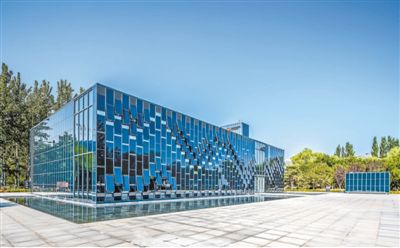China strives to boost prevalence of green buildings
In recent years, China has witnessed a leapfrog development in the field of green building construction. The proportion of urban green buildings in all new buildings increased significantly from 2 percent in 2012 to 65 percent in 2019.

Photo shows the building covered by photovoltaic modules in Changping district, Beijing.
Considering that energy used throughout the whole process of building construction accounted for more than 45 percent of the country's total energy consumption, according to the calculations of a research report, the development of green buildings and carbon emission reduction in the field of construction is undoubtedly of great significance.
Given this fact, the Ministry of Housing and Urban-Rural Development (MOHURD) pointed out at the end of last year that China will redouble its efforts in constructing green architecture.
Various methods are currently being adopted to make buildings greener. A building covered by photovoltaic modules in Changping district, Beijing, serves as a good example of these efforts -- using light photovoltaic walls instead of traditional cement counterparts, the construction is composed of a total of 1,155 thin film photovoltaic modules, which are expected to generate 75,000 kilowatt hours of power annually, and meet 30 to 40 percent of the building’s electricity needs.
In addition to its energy conservation, the building is also characterized by the efficiency of its construction process. Formed by 410 steel structural members, 197 roofing unit plates and 170 photovoltaic curtain wall units prefabricated in a factory, the building was completed in a way similar to that used for assembling building blocks, and took only seven days and nights.
This kind of prefabricated building can be finished in a shorter period of time, and at the same time also effectively reduce air pollution and waste discharge during the construction process.
Relevant research data indicated that compared with the traditional cast-in-situ method, a prefabricated concrete construction project can reduce waste discharge by 70 percent, save on the use of wood by 60 percent, cut down the amount of cement mortar used by 55 percent and conserve water consumption by 25 percent.
In fact, newly prefabricated buildings in 31 provincial-level regions covered an area of 630 million square meters in 2020, an increase of 50 percent over 2019, accounting for about 20.5 percent of the new construction areas, according to statistics provided by MOHURD.
"China started to construct green buildings at the beginning of this century, which is about 30 years later than developed countries. However, the development of its green architecture has been fast," explained an official from the MOHURD, adding that currently, the country's relevant systems have been adapted to international standards.
By 2022, the proportion of green buildings out of all newly-built ones will reach 70 percent, according to an action plan jointly released by MOHURD and seven other departments.
The plan also puts forward key tasks such as promoting the full implementation of green design in new buildings, improving energy and water efficiency, and establishing a supervision mechanism for residential users.
Photos
Related Stories
Copyright © 2021 People's Daily Online. All Rights Reserved.










